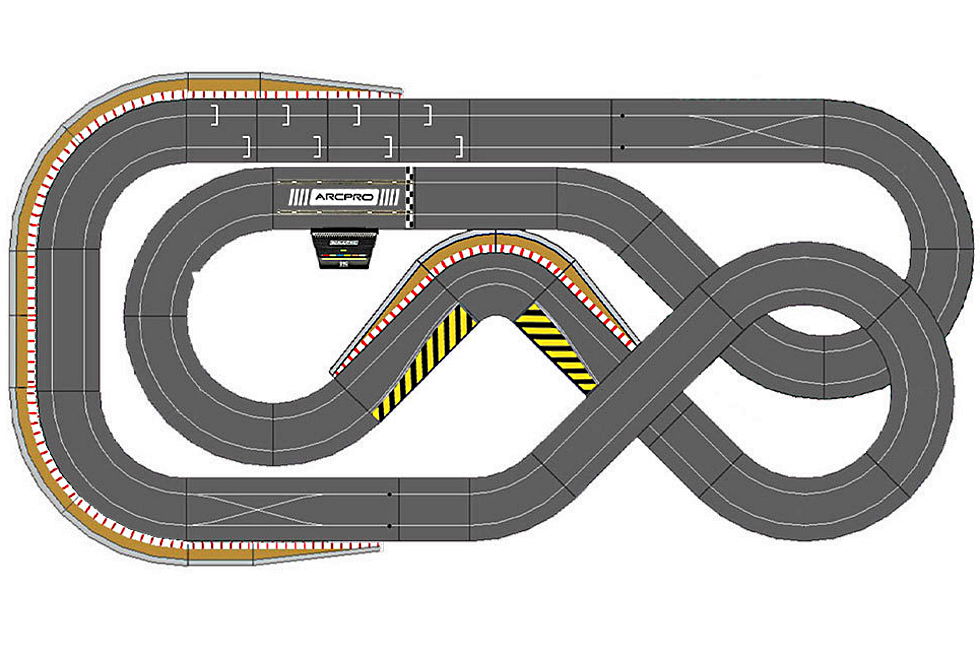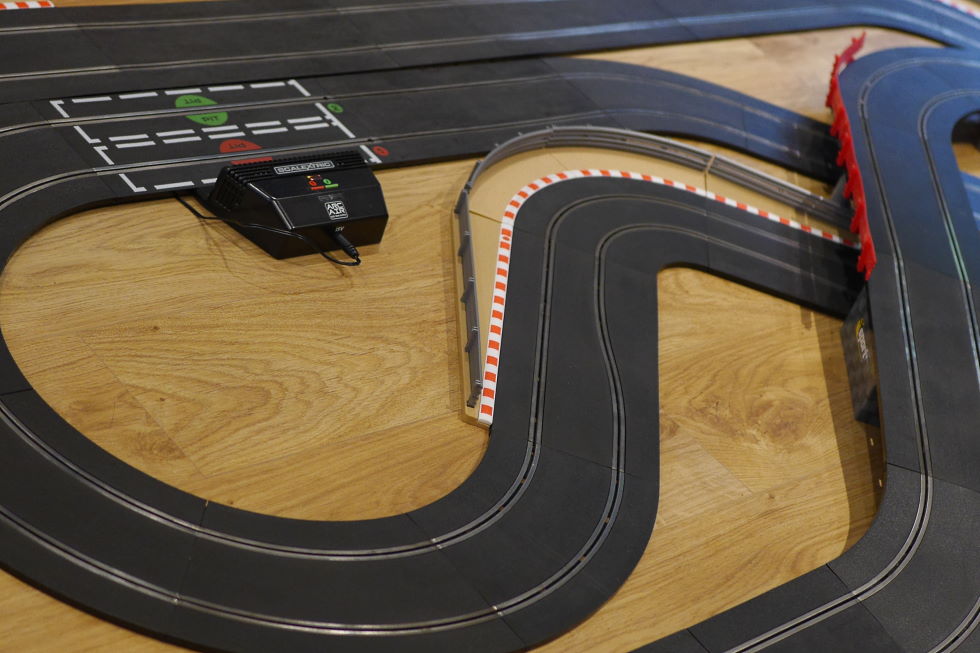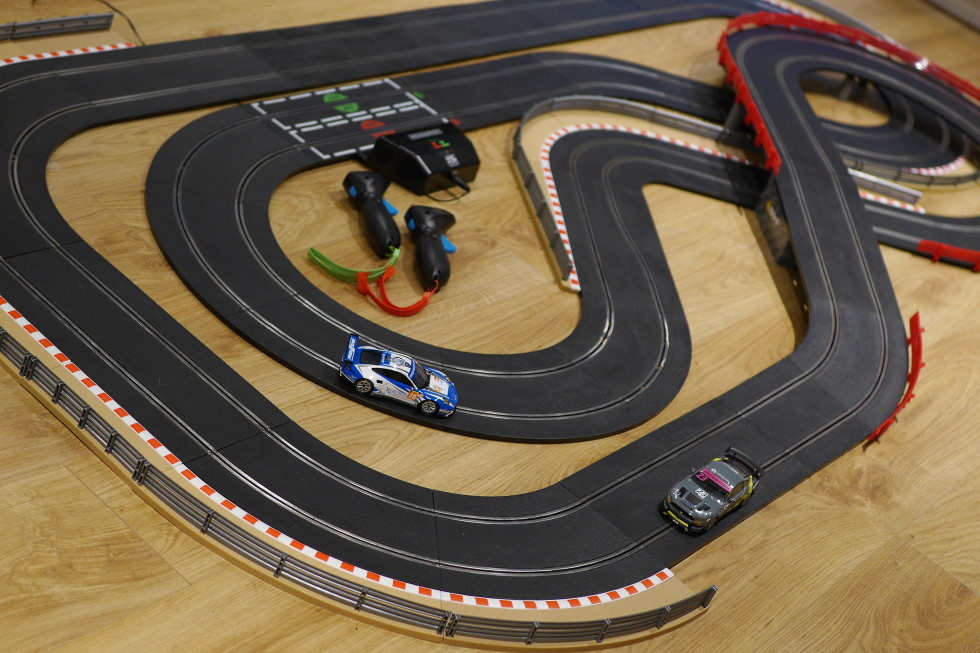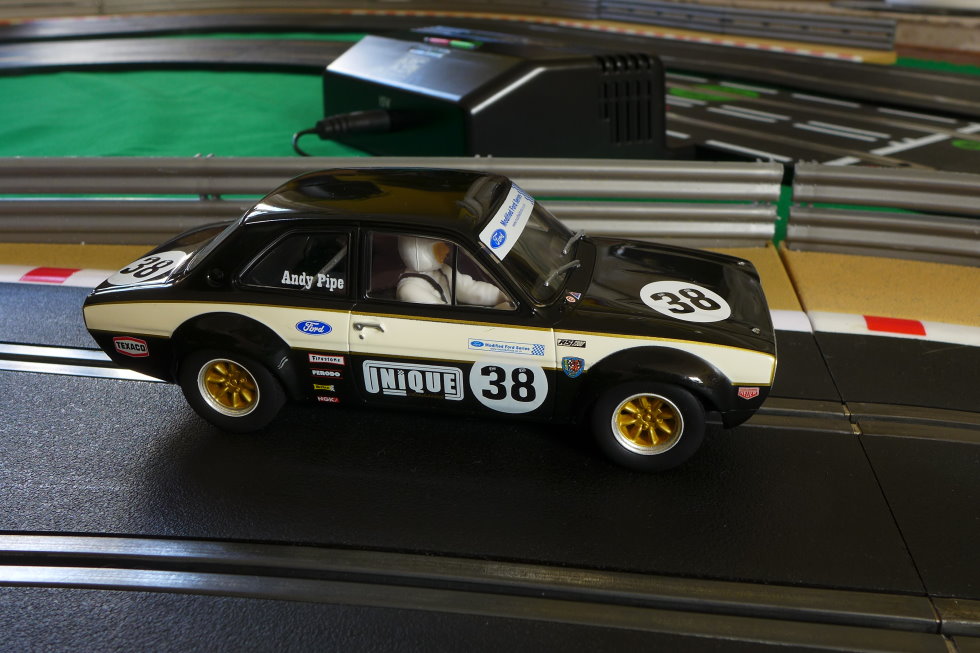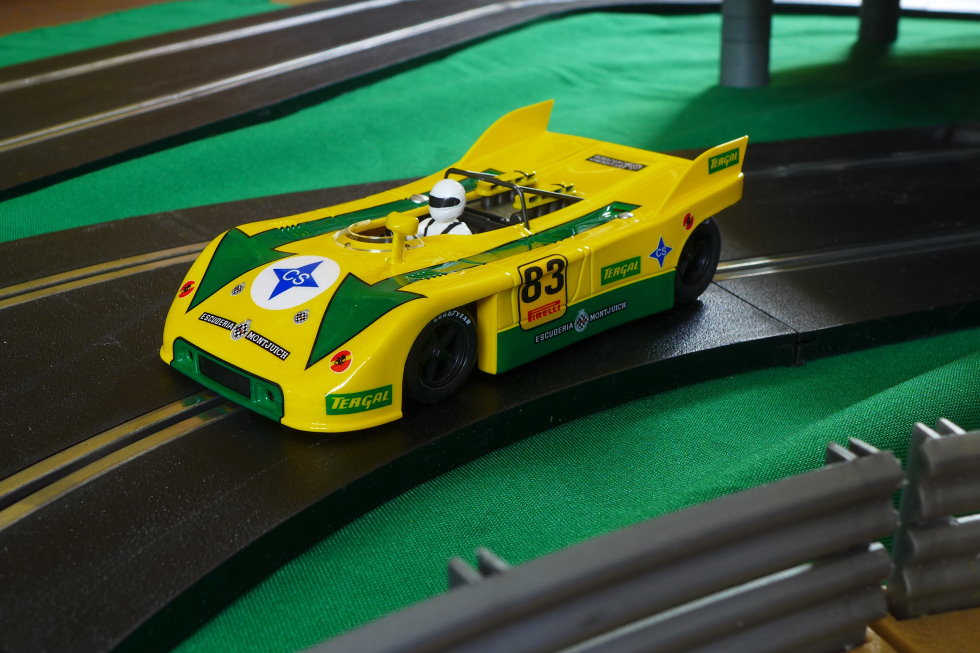Lots of important data for our reviews and ‘How To’ posts comes from the SL6 test track.
The best lap times for all the cars reviewed on the blog will be listed at the end of this post – something we’ll keep updated. Cars will be ranked on their best lap after the “three basic tweaks” – but pre-tweak data will also be included. You might want to build the same track and see if you can beat the times!
I thought it was important to have an out-of-the-box product to use as a test track – one that I could easily build at home and readers of this blog could replicate and compare notes. I chose one of the Jadlam SL sets – the SL6 2020 here – and adapted it, removing the lane changers and using an ARC Air powerbase. Functionally, it is the same as the ARC Pro digital layout running in ‘analogue mode’. The only extra things I added were outer borders and barriers (here) round the corner at the end of the main straight, plus some clip-on armco barriers (here) over the bridges and on the outside of the elevated curves.
My first digital set was an old SL package from Jadlams, bought about ten years ago. The SL sets are well-thought-out designs, excellent value and perfect no-hassle ‘proper’ home tracks – a very different kettle of fish to the often underwhelming Scalextric starter sets. Much of the track in my ‘new’ test track dates back to that first SL digital set of mine – and all the track is still in good condition. I now have the track pieces and accessories for the SL6 layout stored in a cardboard box ready for the next test session.
With a circuit length of 10.6 metres (a smidgen under 35 feet), there’s plenty to challenge a new car – a blip of full-throttle down the four and a half foot straight, sweeping corners in both directions, a tight sideswipe Radius-one corner and the elevations of the flyover. The borders and barriers allow the cars some room to drift round the corners too. And that’s all within an eight by four-foot area – perfect for my kitchen floor in a pretty averagely-small UK house.
Set-up takes around twenty minutes to half an hour, giving myself time to sweep the floor, clean the track, tighten any loose tabs and make sure all the connections are good (see my blog post on Looking After Scalextric Track). The first thing to do when set-up is complete, is to pop a drop of INOX MX3 on each braid of my ‘warm-up’ car – this conditions the track and gives perfect electrical conductivity. I drive one lane and then repeat the INOX routine for the other one. The track is now ready for the test subject.
Although the SL6 layout gives a nice balanced digital and analogue race track, I only run my tests on the ‘red’ lane – the one nearest the powerbase unit. This has the advantage of being able to drift cars through all the corners and not being able to lean on the armco barriers over the elevated section. Sticking to one lane also gives 100% comparable laps times and scores.
The race set-up in the ARC app is a two minute endurance race with a live start and all the other features – fuel, tyres, weather etc – switched off. It’s the car being tested here, not my race strategy. Of course, Max Power is at 100% and the Throttle Curve is the default Profile A – unless I mention otherwise in the review or tuning article. I am using the standard ARC Air power pack and a standard ARC controller. Apart from the INOX at the start of the session, the only routine maintenance will be cleaning rear tyres on masking tape before each timed run.
During the two minutes of the test I am pushing to find the limits of the car, but aiming not to crash – one or two spins or offs is okay, but only if it’s the car’s fault! I race sixty minute stints at big endurance events, so two minutes is perfectly reasonable to concentrate on the test… and waiting for the cheer from the ARC app when it’s time to stop.
At the end of the two minutes, I jot down the number of laps, my best lap and how many crashes or spins – plus any other observations. And I save the results as a screen grab to post on the blog article.
Jadlam SL6 Test Track Leaderboard
Best lap is after the three basic tweaks, unless stated.
3.30 seconds – NSR Porsche 997 GT3 (Performance Slot Cars Part 5). 32 laps. Non-magnet: 23 laps & 4.94 seconds
3.37 seconds – NSR Audi R8 LMS (Tuning Part 8). 30 laps. Non-magnet: 24 laps & 4.67 seconds
3.64 seconds – NSR Porsche 908/3 (Review here). 28 laps. Non-magnet: 22 laps & 5.24 seconds
3.77 seconds* – Scalextric Pagani Huayra Roadster BC (Preview here). 29 laps. Non-magnet: 22 laps & 5.20 seconds
3.90 seconds – Slot.it Maserati MC GT3 (Performance Slot Cars Part 5). 28 laps. Non-magnet: 25 laps & 4:44 seconds
3.97 seconds* – Scalextric Chevrolet Camaro Z/28 (Preview here). 28 laps.
4.00 seconds – Slot.it Porsche 956 (Review here). 28 laps. Non-magnet: 23 laps & 5.07 seconds
4.01 seconds – Scalextric BMW 330i M-Sport (Review here). 28 laps. Out-of-the-box: 26 laps & 4.36 seconds
4.09 seconds* – Scalextric Porsche 911 3.0 RSR (Preview here). 28 laps.
4.11 seconds – Scalextric Ford Escort Mk1 – Andy Pipe Racing (Review here). 27 laps. Out-of-the box: 24 laps & 4:44 seconds
4.15 seconds – Scalextric Aston Martin Vantage GT3 (Review here). 26 laps. Out-of-the-box: 20 laps & 5.21 seconds
4.19 seconds* – Scalextric Plymouth Barracuda (Preview here). 27 laps.
4.23 seconds* – Scalextric Chevrolet Corvette C8R (Track test coming soon). 26 laps. Non-magnet: 23 laps & 4.96 seconds
4.28 seconds – Scalextric Porsche 911 RSR GTE (Tuning Part 4). 26 laps in two minutes
4.38 seconds – Scalextric Ford Capri Mk3 (Review here). 25 laps. Out-of-the-box: 22 laps & 4.65 seconds
4.38 seconds – Carrera Plymouth Road Runner (Review here). 24 laps. Out-of-the-box: 24 laps & 4.59 seconds
4.61 seconds* – Scalextric Jaguar XJS (Preview here). 24 laps.
4.75 seconds – Scalextric Ford Mustang GT4 (Review here). 23 laps. Out-of-the-box: 15 laps & 6.95 seconds
5.28 seconds – Policar Lotus 72 (Review here). 21 laps. No magnet car. Non-magnet: 21 laps & 5.28 seconds
5.34 seconds* – Scalextric 1966 Batmobile (Preview here). 20 laps.
*Preview samples – no post-tweak times available



